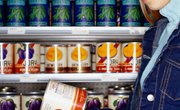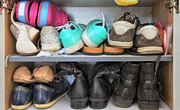Preparing to go to college and live in a dorm can be both an exciting and stressful time. Dorm life requires more than just clothes and a shower caddy: To be comfortable you need several bedding, bath and storage items. Additionally, you may want to invest in a few appliances and utensils to make your experience a bit easier. By preparing and planning carefully, you can ensure that you have everything you need to live comfortably in your dorm.
Clothes
In addition to your regular clothes, be sure to take climate-appropriate outerwear, shoes and clothes that you will use for the first few months. For example, if you are going to school in Southern California, light sweaters for evening, sandals and possibly beachwear in addition to lighter summer and fall clothes would be appropriate. If you are headed to a colder climate, be aware that fall can come quickly, so pack some heavier layering clothes and shoes. Also, be sure to bring a bathrobe and pajamas to get back and forth from the showers in style and comfort.
Bedding
Most dorm rooms have extra-long twin beds that can be uncomfortable, so be sure to bring extra-long twin sheets and, for the best sleep experience, an egg crate or memory foam mattress pad. If possible, bring two sets of sheets so you make your bed with clean sheets even if you have to wait for one set to be washed. Bring comfortable pillows, and if you like to read or do homework in bed, consider bringing a bed reading pillow with arms. Most dorms vary in temperature, so bring a comforter and a blanket so you can always rest in comfort.
Bath and Laundry
Many dorms have communal showers, so buy a shower caddy for quickly toting your things back and forth. Bring your bathroom essentials and a pair of flip-flops for the showers. Bring at least two sets of towels and washcloths as well. A collapsible laundry basket and washing supplies are also essential.
Storage
Dorm space can be very small, and storing and organizing your things efficiently can make the difference between a cluttered nightmare and a peaceful, organized space. You can increase storage space with underbed bins to hold your things, bed lifts to raise the height of your bed to provide more storage space, stacking drawers and a closet organizer.
Appliances and Utensils
Many dorms limit the types of appliances you can bring; check and see if a microwave and refrigerator will work in your dorm. If so, it can be a wonderful convenience to be able to have food and cook in your room. A computer, printer, reading lamps, electric kettle, plates, cups and eating utensils are essential items. A television, iron, fan and small vacuum are not essential but make dorm life more pleasant.
Related Articles
References
Writer Bio
Based in the Pacific Northwest, Arin Bodden started writing professionally in 2003. Her writing has been featured in "Northwest Boulevard" and "Mermaids." She received the Huston Medal in English in 2005. Bodden has a Master of Arts in English from Eastern Washington University. She currently teaches English composition and technical writing at the university level.











